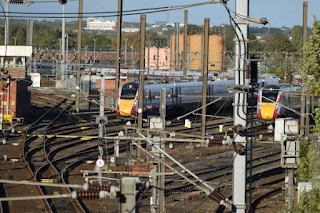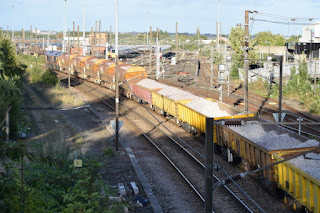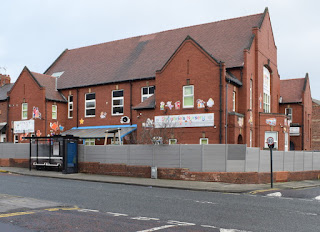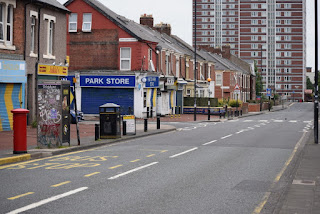Heaton is located in the east end of Newcastle, it is bordered by the neighbouring areas of Benton and Cochrane Park to the north, Walkergate to the east, Byker to the south and Jesmond and Sandyford to the west.
The name 'Heaton' means high town, referring to the area being situated on hills above the Ouseburn.
In the 12th century Heaton became part of the Barony of Ellingham granted by Henry I to Nicholas de Grenville. In the 17th century the Heaton estate was purchased by Henry Babington who was knighted at Heaton Hall by James I on May 1, 1617.
By the 18th century, Heaton was a coal mining area with many of its collieries owned by Matthew White and Richard Ridley. The Heaton estate was broken up in 1835 when the area became officially incorporated into Newcastle upon Tyne. Much of the land in Heaton in 1840 was owned by Amourer Donkin, who on his death in 1857 bequeathed the land to his business partner, the industrialist Sir William Armstrong.
In 1879, the corporation acquired part of the Heaton Hall estate which was laid out as Heaton Park, and Sir William Armstrong donated Armstrong Park and Jesmond Dene to the city. The three parks run into each other to form a green chain through east Newcastle.
During the 19th century, the building of the railways saw the East Coast Main Line pass through Heaton, housing a major rail depot. Heaton also became the location of Sir Charles Parsons engineering works producing turbines.
Heaton was also home to Newcastle United under their previous name Newcastle East End F.C. between 1882 and 1892, East End played at the Heaton Junction Ground on Chillingham Road before moving to St James' Park.
Jack Common (1903-1968), the author of 'Kiddar's Luck' and 'The Ampersand', was born and brought up at 44 Third Avenue, Heaton, and attended Chillingham Road primary school; his novels give a vivid portrait of the area in the early 20th century. Common was later to model for the bust of Karl Marx which tops Marx's tomb in Highgate Cemetery, London. Third Avenue was also the birthplace of the Ringtons Tea business.
Nowadays, Heaton is a mixed working class and middle class area. In recent years it has become a popular residence for many students attending the city's two Universities, Newcastle University and Northumbria University.
Text adapted from Wikipedia.
26th December 2023


Mowbray Street.
A neat looking Citroen Ami 8.
5th October 2023





Heaton Park Road Works.
An enhanced cycle lane and a zebra crossing will make it easier for people, particularly children, to cross Heaton Park Road on the way to and from the nearby Hotspur Primary School.
12th September 2023





Heaton Park Road Works.

Heaton Park Road.
Near the entrance to Heaton Park.
29th August 2023






Heaton Park Road Works.
9th August 2023


No. 1 First Avenue.

Roxburgh Place.
4th May 2023

King John Street.

Heaton Grove/Cornwell Lane.
20th April 2023

The Stadium/The Tip.
The honourable gentleman in front was picking up other peoples litter as he walked his dog.
9th April 2023

Heaton Park Road/Heaton Park View L.T.N.
31st March 2023

South View West/Elizabeth St L.T.N.
6th March 2023










Chillingham Road, Derelict Property.
This old works building stands near to the entrance to Chillingham Road Metro Station. It has been empty for as long as I can remember. Clearance of the bushes around it suggests it's probably due for demolition.
On a seperate note the last photo shows the sad sight of yet more cut down trees here in Newcastle. I have never known so many trees around the city being felled. Sad times.
20th February 2023



Chillingham Road, Derelict Property.
As above but these few photos were taken with my phone in case it was demolished before I got back with my camera.
15th February 2023


Balmoral Terrace/Heaton Road.


King John Street/Heaton Road.
These areas used to be small playgrounds when I was a lot younger. At least one of the areas contained wooden horses that you could sit on.
12th February 2023

Heaton Close.

North View.
24th October 2022



Tynemouth Road Explosion.
An 'explosion' at an industrial premises which left almost 150 homes without electricity was sparked by a build-up of water, it has been revealed.
1st October 2022




Heaton Junction.
22nd July 2022


Chillingham Road Metro Station.
A neat looking truck that doubles up as a train used in the renewal of overhead lines.
5th May 2022



Benton Bank, The People's Theatre (Lyric).
The People’s Theatre is a landmark in its setting; the green pantile roof contrasts with the red brick with stone detailing and makes the art deco style building stand out from its surroundings.
The building is beloved of many theatregoers in the city and those who recall its initial use as a cinema. Originally opened in January 1936, the Lyric Cinema was constructed by Thomas Clements and Sons to the design of Marshall and Tweedy architects of Newcastle.
In 1959 the cinema was bought by the People’s Theatre (established 1911) and converted in to an arts centre. The theatre remains in use and hosts local and amateur productions as well as national touring productions. The centre is also the home of the Young People’s Theatre, which was established in 1963.
Source: Sitelines.


Yarn Bombing, Chillingham Road.
Yarn bombing (or yarnbombing) is a type of street art that employs colourful displays of knitted or crocheted yarn or fibre rather than paint or chalk. It is also called wool bombing, yarn storming, guerrilla knitting, kniffiti, urban knitting, or graffiti knitting.
4th May 2022

Heaton Park Road.
Graffiti in the back lane on the western side.
17th April 2022


Holmeside Place.
6th April 2022


Heaton Park Road.
Recent renovations to no. 150 revealed a sign from an older shop on the same site.
21st March 2022



The Stadium.
Outdoor gym equipment near the cycle path over The Stadium.
7th February 2022

Seventh Avenue.
Collapsed wall I'm guessing due to the recent storms we have endured.
31st December 2021



Chillingham Road.

Brew and Bite, Chillingham Road.





Chillingham Road Primary School, Ninth Avenue.
Chillingham Road Primary School is a fine example of a red brick Victorian school. It was first opened in 1893, and consists of two main buildings within a school yard surrounded by a wall complete with original gateposts and decorative wrought iron gates.
Impressive ornate chimneys today form the basis of the school’s badge. The school is associated with the author Jack Common, who attended the school from 1908. Common, a friend and correspondent of George Orwell, vividly describes his experiences at the school and in the North Tyneside area in his autobiographical novel Kiddar’s Luck.
Source: Sitelines.


St Gabriel's Nursery, Chillingham Road.


The Northumberland Hussar, Sackville Road.






Ravenswood Primary School, Ravenswood Road.
A few photos for reader Jimmy now living on the south coast.


Chas Chandler's House, Second Avenue.
Chas Chandler 1938-1996. Founder member of the 'Animals' Manager of Jimi Hendrix and Slade. Co-founder of Newcastle Arena.
Lived in this house 1938-1964.

Third Avenue Postbox.

Heaton and Byker Spiritualist Church, Tosson Terrace.
25th November 2021








Heaton Park View, old Heaton Library.
The library was commissioned by Alderman Sir William Haswell Stephenson (Mayor of Newcastle in 1875, 1884, 1894 and 1902) to commemorate the Diamond Jubilee of Queen Victoria. It was opened as Victoria Free Library by Earl Grey on 15th October 1893. Stephenson also funded Elswick Library. The book stock at both libraries was identical as a cost-saving exercise, so the catalogue could be duplicated.
The architect for the Victoria Library and Stephenson's last library, Lady Stephenson Library on Welbeck Road, was John W Dyson.
A single-storey children's library was added to the west in 1939. It was extended again in the 1960s. It later became council offices and closed by 2008.
It has since been renovated and houses a dental practice on the ground floor and commercial space on the first floor. The extensions have been demolished. Glazing has been replaced.
The building is built in Flemish-bonded red brick and sandstone in Jacobean-revival style. Tiled roof with crested ridge tiles. A small but ornate timber ventilation lantern rises from the centre of the roof, rising to a tall finial. There is a ventilated chimneystack on the north-west corner of the roof, detailed with gablets, a pitched tiled roof and louvred openings.
Three bays rise to a large gabled wall-head dormer which overhangs eaves level. Each dormer has a gable with sandstone coping, inset with a rectangular carved panel depicting the Stephenson Coat of Arms with the words 'FIDUS IN ARCANUM' (faithful to a secret), the Royal Coat of Arms and the Coat of Arms of the City of Newcastle.
The main central entrance comprises a square-headed door with moulded architrave, flanked by Doric pilasters and rising to a lead-covered canopy on Doric consoles. There is a similar entrance in the western bay. Both have original panelled doors. The windows are transomed and mullioned but have aluminium windows.
The central apron has an ornate carved sandstone panel inscribed 'VICTORIA LIBRARY'. On the west elevation there are scrolled curvilinear parapets and a stained glass window to the stairwell.
INTERIOR - the building has been subdivided into two units. The ground floor is occupied by a dental practice and the first floor by a commercial unit. A modern lift has been inserted. The east end has been substantially reconfigured in 2014. No original detailing remains. Doors have been replaced. Original skirting boards, fluted architraves and a closed-string stair with turned balusters survive. The first floor is now open plan. The original coal chute and floor tracks for machinery survive in the basement.
Source: Sitelines.
13th November 2021

Chillingham Road.
Neuron Mobility Scooters outside the Chillingham pub.
26th October 2021
Chillingham Road Primary School, Ninth Avenue.
Fifth Avenue.

Sixth Avenue.
22nd September 2021
Denmark Street.
The former Presbyterian Chapel (later Baptist) on Denmark Street recently converted to a gym.
13th September 2021
East Coast Mainline.
Workers on the east coast mainline. Viewed from Chillingham Road towards Heaton Road.
5th September 2021
Hotspur Street.
Art on the side of a house in at the western end of Hotspur Street.
Falmouth Road.
8th August 2021


Heaton Park Road back lane.

Falmouth Road/Heaton Grove back lane.
8th August 2021
Ouseburn Community Centre.
2nd August 2021

Addycombe Terrace.
N.H.S. Mural on Addycombe Terrace underneath it says "From Heaton, With Love"

Cleghorn Street.
The three rows of terraced houses, Ebor Street, Cleghorn Street and Richardson Street are collectively known as the ‘Railway Terraces’. The houses in this unique collection are brick, with small gardens to the front and back yards and outhouses to the rear, leading on to back lanes. Most of the buildings retain their original chimneys, and some have original roof lights.
The houses on Ebor Street and Richardson Street have boot scrapers set in to the walls at the front of the houses, which may provide clues as to the occupation of the people the terraces were constructed for.
Source: Sitelines.

Ebor Street.


Heaton Community Centre, Tosson Terrace.
These Victorian buildings which are now utilised by the community of Heaton as an adult education centre and a community centre were originally built as a school. There are several buildings on the site, all of red brick and of various designs. The buildings are plainly decorated, often with small details such as sandstone keystones and roof capping.
On the south elevation of the single storey buildings at the south of the site, the windows are capped by arches of upended bricks, a feature repeated on the north façade of the tall buildings at the north of the area.
North Heaton Council School was formally opened on 3 March 1904 with Infants, Junior and Senior Mixed Departments. The school was located on Tosson Terrace. In 1927 the school was reorganised. The Infants merged with the Juniors to form a single department and moved into the old Junior Department building, while their previous premises were taken over for use as a Technical School. As a result the School consisted of a Junior Mixed and Infants Department and a Senior Mixed Department.
In 1932 the Senior Department was reorganised as a Senior Girls' Department, with the boys transferring to Chillingham Road Boys School. Following the 1944 Education Act the Senior Girls Department was redesignated as North Heaton Secondary Modern School for Girls and then as North Heaton County Secondary School for Girls.
The Junior and Infants Department closed in 1952 and its pupils were transferred to the new Ravenswood County Primary School. The Girls' School closed in 1967 and the building was taken over by Manor Park School. The majority of the pupils transferred to Benfield Comprehensive School.
General observations of OS maps indicate that the linked single and two storey buildings in the north west corner of the site post-date the main late-Victorian style school buildings, appearing at some point in the interwar period. This is reflected architecturally in features such as the flat segmental window arches with sandstone keystones. In contrast, the windows of the late-Victorian style buildings carry mostly round segmental brick arches and sandstone lintels when located under the eaves.
Source: Sitelines.

Heaton Train Depot.
Richardson Street.

Spencer Street back lane.

Sainsburys, Chillingham Road.
Peggy Sue's Diner, Chillingham Road.
Chillingham Road.

Chillingham Road.
Looking north up Chillingham Road from the East Coast mainline.

Hot Yoga, Chillingham Road.


Shops on Chillingham Road.

The Chillingham, Chillingham Road.
25th July 2021

Heaton Park Road.
Heaton Grove.
An otherwise drab back lane looking great thanks to planters in Heaton Grove back lane.
Cheltenham Terrace.
On April 25 1941 German bombers dropped bombs, showers of incendiaries, and a parachute mine on the east end of Newcastle killing 47 people. This photo shows the flats that were built in place of the demolished houses.
You can read more about the raids at the Heaton History Group website.
1st May 2021

"The Stadium" or "The Tip".
In March 1950 Newcastle City Council announced plans to lay out a City Stadium on the former Ouseburn refuse tip on Warwick Street. The Ouseburn flowed under the site through a large culvert. The initial plan was to cover the site in soil and turf and lay out a football pitch and cycling and running tracks. The ultimate aim was to build two stands on either side of the track, each to seat 43,000 people. A terrace at the Warwick Street End would accommodate 8,500.
This stadium would have been bigger than St. James Park. The site would also house an indoor sports centre with badminton courts and an ice rink. Underneath the stadium would be a multi storey car park. The first phase of the stadium (the football pitch and racing tracks) opened in June 1955.
There was a cinder track, a small wooden pavilion and an entrance block. Plans for the grand City Stadium were abandoned and by 1967 the site had fallen into disrepair.
Today the site is open parkland with a children's playground and an artificial five-a-side pitch. The cinder running track can still be seen.
Source: Sitelines.
24th October 2016
Heaton Park Road.
22nd July 2012
Huntcliffe Gardens.
On the 21st of July 2012 a gas explosion in Heaton tore apart a house while the owner was still inside.
The house was destroyed in the blast and emergency services were quickly on the scene. The 65-year-old occupant was taken to Newcastle’s Royal Victoria Infirmary, and a 90-year-old neighbour was treated by paramedics at the scene for shock.
A video from ChronicleLive on YouTube
19th October 2011

The old Heaton Library's conversion.
6th October 2011

Falmouth Road.
June 2011

The old Heaton Library's conversion.
May 2011


The old Heaton Library's conversion.
29th March 2011

The old Heaton Library's conversion.
2nd March 2011

The old Heaton Library's conversion.
21st January 2011

The old Heaton Library's conversion.
3rd November 2010


The old Heaton Library's conversion.
11th October 2010


The old Heaton Library's conversion.
8th September 2010

The old Heaton Library's conversion.
25th July 2010

The old Heaton Library's conversion.
20th July 2010

The old Heaton Library's conversion.
13th July 2010

The old Heaton Library's conversion.
21st June 2010
The Addison/Grafton Estate.
3rd July 2009
r.jpg)
r.jpg)
r.jpg)
Addycombe Terrace.
A few photos of a hole that opened up in the back lane of Addycombe Terrace in Heaton during the recent floods. At the height of the storm, the deluge caused a water pipe to burst and the back street to crumble under the strain.
The Addison/Grafton Estate.
12th May 2009
Heaton Park Road back lane.
13th February 2009
Heaton Park Road.
r.jpg)
Hotspur Street.
14th October 2008
r.jpg)

80, Second Avenue.
Photos for Les Hinchliffe who lived there before moving to Wales.
28th September 2008
r.jpg)
r.jpg)
Heaton Park Road.
r.jpg)
Between Heaton Road and Heaton Park Road.
r.jpg)
Second Avenue.
r.jpg)
r.jpg)
Denmark Street.
r.jpg)
Ringtons Tea, Algernon Road.
This building was constructed to house the head office of the famous Newcastle firm, Ringtons Tea.
The front of this six storey white stone building is quite distinctive, especially with its ornately sculptured gable. Although the building is no longer occupied by the company the large signage on the façade reading ‘Ringtons Limited Tea Merchants’, ‘Est. 1907’, and ‘Ringtons Ltd 1924’, still exists.
The company was established in 1907 by Samuel Smith and William Titterington, and it is the ‘rington’ part of the latter name coupled with the ‘S’ from Smith that gave birth to the name. Today Ringtons are one of the largest tea producers in Britain.
Source: Sitelines.
r.jpg)
r.jpg)
r.jpg)
Heaton Park Road.
r.jpg)
The old Heaton Library.
r.jpg)
Addison/Grafton Estate.
r.jpg)
Simonside Terrace.
r.jpg)
North View.
Site of the now demolished Heaton Railway Station on North View.
r.jpg)
Addison Grafton Estate.
r.jpg)
r.jpg)
Cardigan Terrace.
r.jpg)
r.jpg)

r.jpg)
Chillingham Road.
Photos of Stannington Grove/Avenue area that were requested by an ex-resident Muriel now living in Canada.
r.jpg)
r.jpg)
Stannington Grove.
r.jpg)
Stannington Avenue - Stannington Grove.
r.jpg)
Heaton Hall Road - Stannington Avenue.
r.jpg)
r.jpg)
Stannington Avenue.
5th April 2008

The Chillingham pub, Chillingham Road.
12th January 2008

Heaton Railway Junction.
The more recent Chillingham Road Metro Station on the right.

Chillingham Road.
29th October 2007
r.jpg)
Addison Grafton Estate.
r.jpg)
N.H.S. walk in centre behind Shields Road.
10th July 2007

Stratford Road.

Addison Grafton Estate.
21st May 2007

Hotspur Street.
19th May 2007

Chillingham Road Metro Station.
18th May 2007
r.jpg)
Cardigan Terrace.
r.jpg)
Back of Heaton Park Road.
10th April 2007
r.jpg)
"The Stadium" or "The Tip".
5th January 2007

The Peoples Theatre on Stephenson Road.
30th December 2005

Snowfall near Hotspur Primary School.

The 'Shakespeare House', South View West.
Image of William Shakespeare in brickwork on gable end of 47 South View West. Exact date unknown but probably created when gable end was tidied up following demolition of the south-west end of the street presumably in the late 1970s.
Source: Sitelines.
19th September 2005

Burnt out car at 'The Stadium' or 'The Tip'.
More Information:
- Sitelines - Heaton, Stratford Road, Robin Sheeps Cave
- Wikipedia - Heaton
- Chronicle Live - 28 Archive photographs of Heaton
- Heaton History Group
- Flickr - North View School Heaton Photo from 1966
- Flickr - North View School Heaton Photo from 1951
See my other photos around Heaton:
- Heaton Road
- Heaton Road - Cycle Lane Construction 2022-2023
- Heaton Road - Former Elim Pentecostal Church
- Heaton Road - Heaton Baptist Church
- Heaton Road - St Gabriel's Church
- Heaton - Iris Brickfield
- Heaton Park
- Heaton Park - House of Adam
- Heaton, High
- Heaton, High - Benton Road & Four Lane Ends
- Heaton, High - Heaton Cemetery
- Heaton, High - Paddy Freemans Park

















15 comments:
Once again you've outdone yourself with your great pictures of Heaton. Much of it hasn't changed, thank goodness and and it is nice to be reminded of my childhood playground, even the "Peoples Theatre" at which I spent many hours when it was the Lyric Cinema!
Thanks. The hardest part of putting this post together was deciding which images to leave out as I have hundreds of photos of the area.
Another day in the mythical place they call Newcastle in which it never rains - daaaamn yooo! :-)
If only it never did rain then this site would be twice as busy :)
Did you see any of the races held around the Newcastle quayside on Saturday on the BBC. It never stopped raining!
hi could you plz put some pics up of newton road in high heaton? I used to live there now it's been 9 years since i wnt there. Also cud u plz put some pics up of ravenswood primary school? thankyou i would really appreciate it!
Here you go High Heaton. For some reason I did'nt put it in the sidebar.
This website has proved very useful in my geography A-level! thanks a lot! :)
We really have a beautiful city!
You are most welcome. :)
Does anybody remember the clark family that lived on warwick street and stratford grove west there was arthur, jim, frank, jim married liz gilchrist from shieldfield I think they had a sister called moyra
Hi there!
Great pics, very comprehensive!
Do you know where Townsville House was situated? There was a shipping publication company situated there.
Does anyone know if 17 Sixth Avenue still exists.I am trying to find where my grandmother lived there in Heaton around 1915 to 1921 approx.
Any photos or information would be greatly appreciated.I visited there last year from Australia tracing my grandparents but never knew my grandmother lived there.
Kind Regards
Merrin Keegan
Pretty sure sixth Avenue still exists, I used to live in 1st ave for a while....I’m not to far away,I’ll pop round and have a look next time I’m passing
Re...Townsville house......it’s still there, 274 heaton rd.
247 heaton road
Still there, can get a pic but not sure how to send it to u
Post a Comment